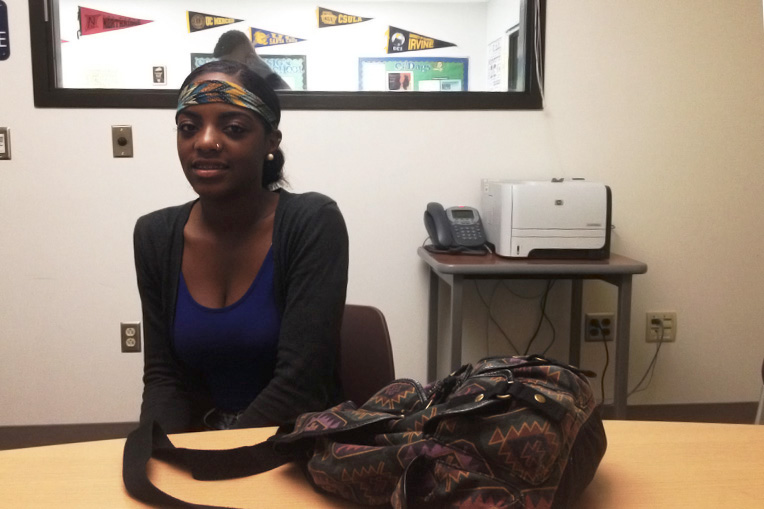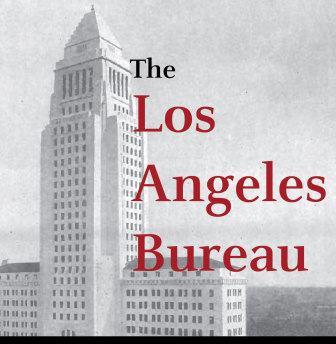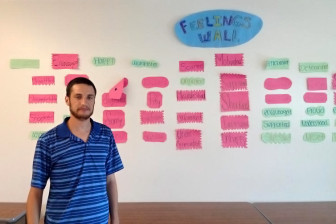
Sarah Zahedi
Mykia Moore, a student at Augustus Hawkins High School, got into a fight with her best friend last year over a boy. "It was just my anger and not knowing how to get out my feelings differently,” she said.
When high school sophomore Mykia Moore got into an argument with her best friend over a boy last year at Augustus Hawkins High School in South Los Angeles, the dispute quickly escalated into a physical fight.
“She thought I wanted her boyfriend, because he texted me saying he wished he met me first,” Moore said. “And I was like, 'I hope you know I have to tell my friend this before she thinks I’m talking to her boyfriend behind her back.'”
 When Moore went to her friend, things seemed to go well. The friend said she believed Moore would not do anything to hurt her. Then, other students began to spread rumors that said otherwise.
When Moore went to her friend, things seemed to go well. The friend said she believed Moore would not do anything to hurt her. Then, other students began to spread rumors that said otherwise.
“Other people were in her ear, telling her that I wanted him. So we started to fight over ‘He said, she said,’” Moore said.
As the fight continued, Moore said she became angrier and angrier. Next thing she knew, she hit her friend.
“I hit her first,” Moore said. “I really let my anger take over and get the best of me."
Instead of getting suspended by the school’s administrators and teachers who stopped the fight, Moore caught a break. Three days after the fight, she was sent to her school’s restorative justice program coordinator, Joseph Luciani.
Restorative justice is a theory of justice that emphasizes repairing the harm caused or revealed by criminal behavior. At Augustus Hawkins High, Luciani holds conflict resolution and community-building circles, where students resolve their issues by talking them out with each other, witnesses and involved teachers and administrators.
At first, Moore doubted that the conflict resolution circle would work.
“It was like, ‘Oh my God, we have to have a stupid circle,'" Moore said. “I thought it was just not going to work. I thought I’d still be the same person afterwards.”
But after Moore and her friend spoke to Luciani, Moore said, her perspective changed.
Before the girls began to talk, Luciani explained the circle guidelines. First, they were told to respect the talking piece, an object that is passed from person to person in the circle. Luciani said whoever holds it has the right to speak, while others have the right to listen so everyone has the same opportunity to share.
They were then told to speak and listen from the heart, so they could say what they felt and try to understand where everyone was coming from. Next, Luciani told them to bring their best attitudes to the circle and to say just enough, to be mindful of the time they each had to talk.
Finally, and Luciani said, most importantly, they were told to honor each other’s privacy, so that the students could feel like the circle was a safe space. Moore said that these guidelines allowed them to fully talk out their problems and to say what was on their minds.
“There was first a lot of back-and-forth going on and a lot of arguing. But, when we got to know where each other was coming from, I was just thinking in my head, ‘Why am I doing this when I really want to be this person’s friend?'” Moore said. “I didn’t mean what I did. It was just my anger and not knowing how to get out my feelings differently.”

Sarah Zahedi
Joseph Luciani, a restorative justice program coordinator for students at Augustus Hawkins High School, stands in front of one of the program's outlets of expression, the "Feelings Wall."
Before he began work as a restorative justice coordinator at Augustus Hawkins High School, Luciani studied the subject at Eastern Mennonite University’s Center for Justice and Peacebuilding in Virginia.
Unlike suspension, the restorative justice program at Hawkins allows students to get to the root of their problems, he said. “It shifts the questions of what rules have broken, who’s guilty and what punishment is deserved, to who is harmed and how can we repair the harm?”
Luciani said this kind of program is especially useful to students in South LA, given that their community suffers from excessive levels of violence, poverty and gang abuses.
“These are the challenges that our students are dealing with on a daily basis,” Luciani said. “These circles are tools of restorative justice that help them to deal with conflict in a healthy way instead.”
Augustus Hawkins High School’s restorative justice program started in August 2013. The California Center for Equality and Justice, a human relations organization dedicated to confronting bias, bigotry and racism in the United States, submitted a grant proposal to the LA Unified School District (LAUSD) to commission the program. Restorative justice became a component of the School Climate Bill of Rights passed by the LAUSD in May 2013, which calls for an end to suspensions for “willful defiance” in schools that have particularly targeted students of color and the promotion of positive behavior intervention and supports as an alternative to zero-tolerance policies.
 Currently, Augustus Hawkins High School is one of only five LAUSD schools to launch restorative justice programs. All schools will use restorative justice practices as an alternative to traditional school discipline by 2020, according to the bill of rights.
Currently, Augustus Hawkins High School is one of only five LAUSD schools to launch restorative justice programs. All schools will use restorative justice practices as an alternative to traditional school discipline by 2020, according to the bill of rights.
After just one year, Luciani said the impact has been tremendous, with suspension rates going down by about 65 percent, even with a 30 percent increase in the student population.
This decrease, in Moore’s view, occurred because restorative justice is much more effective than other harsher punitive measures like suspension and expulsion.
“Suspension doesn’t change anything because a lot of kids who get suspended and expelled don’t even care about their work, and don’t mind getting suspended,” she said. “The threat of having to go to circle for getting into a fight is enough because a lot of kids think the circles are stupid and that they will waste their time. They’ll think twice before breaking the rules.”
Just one year after her conflict, Moore said she has become a much more thoughtful person through the restorative justice program, taking a different approach to disagreements.
“If it wasn’t for this program, if it wasn’t for Joseph. I don’t know … I think I’d still be the way I was back then,” Moore said. “But the circle helped me and it made me want to talk with other kids who have conflicts too. I know what it’s like to be in their position.”
At Luciani’s recommendation, Moore took a 12-hour training session to become a community-building circle facilitator herself, guiding other students through their issues at school.
“I love to help people — it’s the best thing,” Moore said. “When I see others fighting, I stop them and I ask, ‘Why don’t we just talk about it?’ It’s the best way.”
Pingback: Juvenile Justice in America: We Can Do Better; News Roundup | Reclaiming Futures